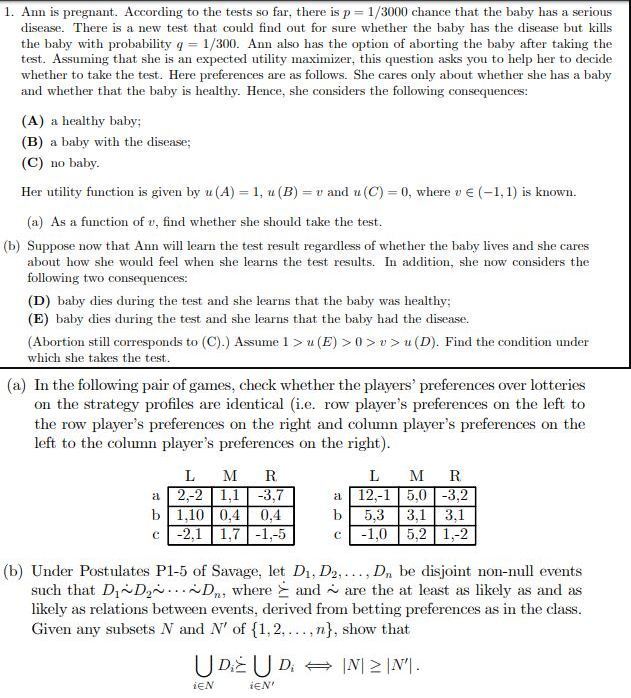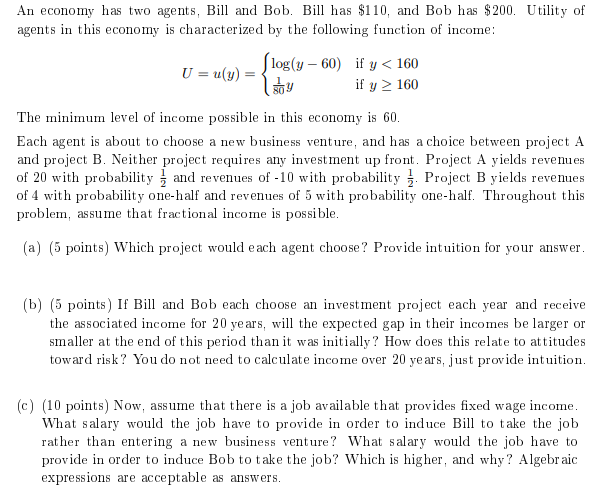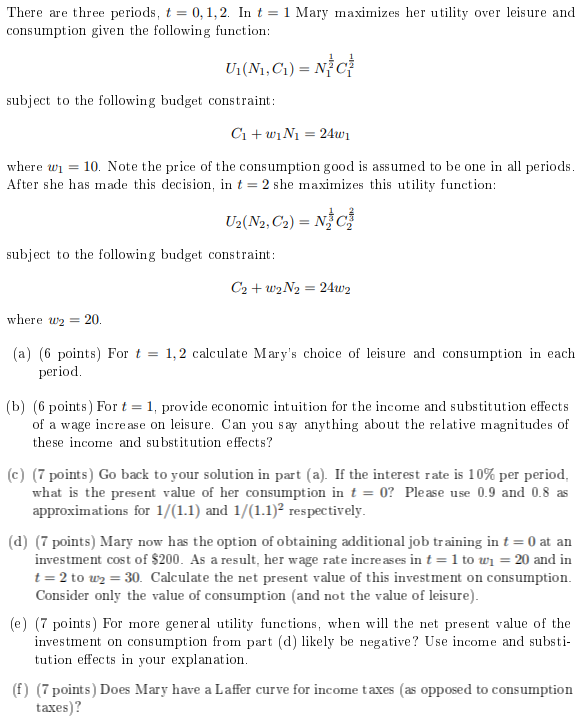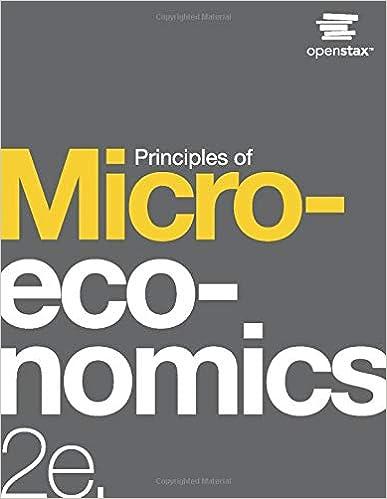Some questions on microeconomics, try and provide solutions for the same
1. Ann is pregnant. According to the tests so far, there is p = 1/3000 chance that the baby has a serious disease. There is a new test that could find out for sure whether the baby has the disease but kills the baby with probability q = 1/300. Ann also has the option of aborting the baby after taking the test. Assuming that she is an expected utility maximizer, this question asks you to help her to decide whether to take the test. Here preferences are as follows. She cares only about whether she has a baby and whether that the baby is healthy. Hence, she considers the following consequences: (A) a healthy baby; (B) a baby with the disease; (C) no baby. Her utility function is given by u (A) = 1, u (B) = v and u (C) =0, where ve (-1, 1) is known. (a) As a function of v, find whether she should take the test. (b) Suppose now that Ann will learn the test result regardless of whether the baby lives and she cares about how she would feel when she learns the test results. In addition, she now considers the following two consequences: (D) baby dies during the test and she learns that the baby was healthy; (E) baby dies during the test and she learns that the baby had the disease. (Abortion still corresponds to (C).) Assume 1 > " (E) > 0 > > > u (D). Find the condition under which she takes the test. (a) In the following pair of games, check whether the players' preferences over lotteries on the strategy profiles are identical (i.e. row player's preferences on the left to the row player's preferences on the right and column player's preferences on the left to the column player's preferences on the right). L M R L M R 2.-2 1,1 -3.7 12,-1 5.0 -3.2 1,10 0,4 0,4 5.3 3,1 3.1 -2,1 1,7 -1,-5 -1,0 5,2 1,-2 (b) Under Postulates P1-5 of Savage, let D1, D2. .... D,, be disjoint non-null events such that Di~Dy~. . .~Dn, where > and ~ are the at least as likely as and as likely as relations between events, derived from betting preferences as in the class. Given any subsets N and N' of {1, 2. ..., n}, show that UD UD - IN12 INI. iEN iEN!An economy has two agents, Bill and Bob. Bill has $110, and Bob has $200. Utility of agents in this economy is characterized by the following function of income: U = u(y) = [ log(y - 60) if y 160 The minimum level of income possible in this economy is 60. Each agent is about to choose a new business venture, and has a choice between project A and project B. Neither project requires any investment up front. Project A yields revenues of 20 with probability = and revenues of -10 with probability -. Project B yields revenues of 4 with probability one-half and revenues of 5 with probability one-half. Throughout this problem, assume that fractional income is possible. (a) (5 points) Which project would each agent choose? Provide intuition for your answer. (b) (5 points ) If Bill and Bob each choose an investment project each year and receive the associated income for 20 years, will the expected gap in their incomes be larger or smaller at the end of this period than it was initially ? How does this relate to attitudes toward risk? You do not need to calculate income over 20 years, just provide intuition. (c) (10 points) Now, assume that there is a job available that provides fixed wage income. What salary would the job have to provide in order to induce Bill to take the job rather than entering a new business venture? What salary would the job have to provide in order to induce Bob to take the job? Which is higher, and why? Algebraic expressions are acceptable as answers.There are three periods, t = 0, 1,2. In t = 1 Mary maximizes her utility over leisure and consumption given the following function: UI(M, CI) = NICE subject to the following budget constraint: Ci + wiN = 24w1 where wi = 10. Note the price of the consumption good is assumed to be one in all periods. After she has made this decision, in t = 2 she maximizes this utility function: U2(N2, C2) = Nici subject to the following budget constraint: C2 + w2 N2 = 24w2 where w2 = 20. (a) (6 points) For t = 1, 2 calculate Mary's choice of leisure and consumption in each period. (b) (6 points ) For t = 1, provide economic intuition for the income and substitution effects of a wage increase on leisure. Can you say anything about the relative magnitudes of these income and substitution effects? (c) (7 points) Go back to your solution in part (a). If the interest rate is 10% per period, what is the present value of her consumption in t = 0? Please use 0.9 and 0.8 as approximations for 1/(1.1) and 1/(1.1) respectively. (d) (7 points) Mary now has the option of obtaining additional job training in t = 0 at an investment cost of $200. As a result, her wage rate increases in t = 1 to wj = 20 and in t = 2 to w2 = 30. Calculate the net present value of this investment on consumption. Consider only the value of consumption (and not the value of leisure). (e) (7 points ) For more general utility functions, when will the net present value of the investment on consumption from part (d) likely be negative? Use income and substi tution effects in your explanation. (f) (7 points) Does Mary have a Laffer curve for income taxes (as opposed to consumption taxes)









